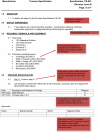Bridge-enhanced ACL repair: A review of the science and the pathway through FDA investigational device approval
- PMID: 25631206
- PMCID: PMC4799652
- DOI: 10.1007/s10439-015-1257-z
Bridge-enhanced ACL repair: A review of the science and the pathway through FDA investigational device approval
Abstract
Injuries to the anterior cruciate ligament (ACL) are currently treated with replacement of the torn ligament with a graft of tendon harvested from elsewhere in the knee. This procedure, called "ACL reconstruction," is excellent for restoring gross stability to the knee; however, there are relatively high graft failure rates in adolescent patients (Barber et al. in Arthroscopy 30(4):483-491, (2014); Engelman et al. in Am J Sports Med, (2014); Webster et al. in Am J Sports Med 42(3):641-647, (2014)), and the ACL reconstruction procedure does not prevent the premature osteoarthritis seen in patients after an ACL injury (Ajuied et al. in Am J Sports Med, (2013); Song et al. in J Sports Med 41(10):2340-2346, (2013); Tourville et al. Am J Sports Med 41(4):769-778, (2013)) .Thus, new solutions are needed for ACL injuries. Researchers have been investigating the use of scaffolds, growth factors and cells to supplement a suture repair of the ACL (bridge-enhanced repair; also called bio-enhanced repair in prior publications). In this paper, we will review the varied approaches which have been investigated for stimulating ACL healing and repair in preclinical models and how one of these technologies was able to move from promising preclinical results to FDA acceptance of an investigational device exemption application for a first-in-human study.
Figures






References
-
- Ajuied A, Wong F, Smith C, et al. Anterior Cruciate Ligament Injury and Radiologic Progression of Knee Osteoarthritis: A Systematic Review and Meta-analysis. Am J Sports Med. 2013 - PubMed
-
- Altman GH, Horan RL, Martin I, et al. Cell differentiation by mechanical stress. FASEB J. 2002;16(2):270–272. - PubMed
-
- Andriacchi TP, Briant PL, Bevill SL, Koo S. Rotational changes at the knee after ACL injury cause cartilage thinning. Clin Orthop Relat Res. 2006;442:39–44. - PubMed
-
- Barber FA, Cowden CH, 3rd, Sanders EJ. Revision rates after anterior cruciate ligament reconstruction using bone-patellar tendon-bone allograft or autograft in a population 25 years old and younger. Arthroscopy. 2014;30(4):483–491. - PubMed
-
- Bellincampi LD, Closkey RF, Prasad R, Zawadsky JP, Dunn MG. Viability of fibroblast-seeded ligament analogs after autogenous implantation. J Orthop Res. 1998;16(4):414–420. - PubMed
Publication types
MeSH terms
Grants and funding
LinkOut - more resources
Full Text Sources
Other Literature Sources
Medical

